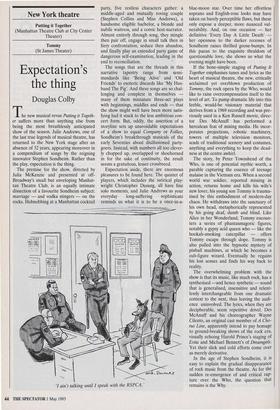New York theatre
Putting it Together (Manhattan Theatre Club at City Center Theater) Tommy (St James Theater)
Expectation's the thing
Douglas Colby
The new musical revue Putting it Togeth- er suffers more than anything else from being the most breathlessly anticipated show of the season. Julie Andrews, one of the last true legends of musical theatre, has returned to the New York stage after an absence of 32 years, appearing moreover in a compendium of songs by the reigning innovator Stephen Sondheim. Rather than the play, expectation is the thing.
The premise for the show, directed by Julia McKenzie and presented at off- Broadway's small but enveloping Manhat- tan Theatre Club, is an equally intimate dissection of a favourite Sondheim subject: marriage — and vodka stingers — on the rocks. Hobnobbing at a Manhattan cocktail party, five restless characters gather: a middle-aged and mutually roving couple (Stephen Collins and Miss Andrews), a handsome eligible bachelor, a blonde and nubile waitress, and a comic host-narrator. Almost entirely through song, they mingle then pair off, engage in small talk then in fiery confrontation, seduce then abandon, and finally play an extended party game of dangerous self-examination, leading in the end to reconciliation.
The songs that are the threads in this narrative tapestry range from semi- standards like 'Being Alive' and 'Old Friends' to esoteric discards like 'My Hus- band The Pig'. And these songs are so chal- lenging and complete in themselves many of them miniature three-act plays with beginnings, middles and ends — that the show might well have been more satis- fying had it stuck to the less ambitious con- cert form. But, oddly, the assertion of a storyline sets up unavoidable expectations of a show to equal Company or Follies, Sondheim's breakthrough musicals of the early Seventies about disillusioned party- goers. Instead, with numbers all too clever- ly chopped up, overlapped or shoehorned in for the sake of continuity, the result seems a gratuitous, lesser crossbreed.
Expectation aside, there are enormous pleasures to be found here. The quintet of players, which includes the satirical play- wright Christopher Durang, all have fine solo moments, and Julie Andrews as your everyday long-suffering sophisticate reminds us what it is to be a once-in-a-
'I ain't talking until I speak with the RSPCA.' blue-moon star. Over time her effortless soprano and English-rose looks may have taken on barely perceptible flaws, but these only expose a deeper, more nuanced vul- nerability. And, on one occasion — her definitive 'Every Day A Little Death' her openness to the darker recesses of Sondheim raises thrilled goose-bumps. In this paean to the exquisite -thraldom of questionable love, she shows us what the evening might have been.
If the bone-simple staging of Putting It Together emphasises tunes and lyrics as the heart of musical theatre, the new, critically acclaimed yet overblown production of Tommy, the rock opera by the Who, would like to raise overcompensation itself to the level of art. To pump dramatic life into this feeble, would-be visionary material that derives from a 1969 recording and was pre- viously used in a Ken Russell movie, direc- tor Des McAnuff has performed a herculean feat of mixing media. He incor- porates projections, robotic machinery, towers of multiple television monitors, scads of traditional scenery and costumes, anything and everything to keep the dead- ness at the centre awhirl.
The story, by Peter Townshend of the Who, is one of potential mythic worth, a parable capturing the essence of teenage malaise in the Vietnam era. When a second world war soldier, reported missing in action, returns home and kills his wife's new lover, his young son Tommy is trauma- tised by this embodiment of modern-day chaos. He withdraws into the sanctuary of his own head, metaphorically represented by his going deaf, dumb and blind. Like Alice in her Wonderland, Tommy encoun- ters a series of phantasmagoric figures, notably a gypsy acid queen who — like the hookah-smoking caterpillar — offers Tommy escape through dope. Tommy is also pulled into the hypnotic mystery of pinball machines, at which he becomes a cult-figure wizard. Eventually he regains his lost senses and finds his way back to reality.
The overwhelming problem with the show is that its music, like much rock, has a synthesised —and hence synthetic — sound that is generalised, insensitive and relent- lessly interchangeable from one dramatic context to the next, thus leaving the audi- ence uninvolved. The lyrics, when they are decipherable, seem repetitive drivel. Des McAnuff and his choreographer Wayne Cilento, an original cast member of A Cho- rus Line, apparently intend to pay homage to ground-breaking shows of the rock era, visually echoing Harold Prince's staging of Evita and Michael Bennett's of Dreamgirls. Yet their slick and cold efforts come over as merely derivative.
In the age of Stephen Sondheim, it is easy to explain the gradual disappearance of rock music from the theatre. As for the sudden re-emergence of and critical rap- ture over the Who, the question that remains is the Why.


























































 Previous page
Previous page